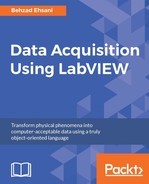Book Description
Transform physical phenomena into computer-acceptable data using a truly object-oriented language
About This Book
- Create your own data acquisition system independently using LabVIEW and build interactive dashboards
- Collect data using National Instrument's and third-party, open source, affordable hardware
- Step-by-step real-world examples using various tools that illustrate the fundamentals of data acquisition
Who This Book Is For
If you are an engineer, scientist, experienced hobbyist, or student, you will highly benefit from the content and examples illustrated in this book. A working knowledge of precision testing, measurement instruments, and electronics, as well as a background in computer fundamentals and programming is expected.
What You Will Learn
- Create a virtual instrument which highlights common functionality of LabVIEW
- Get familiarized with common buses such as Serial, GPIB, and SCPI commands
- Staircase signal acquisition using NI-DAQmx
- Discover how to measure light intensity and distance
- Master LabVIEW debugging techniques
- Build a data acquisition application complete with an installer and required drivers
- Utilize open source microcontroller Arduino and a 32-bit Arduino compatible Uno32 using LabVIEW programming environment
In Detail
NI LabVIEW's intuitive graphical interface eliminates the steep learning curve associated with text-based languages such as C or C++. LabVIEW is a proven and powerful integrated development environment to interact with measurement and control hardware, analyze data, publish results, and distribute systems.
This hands-on tutorial guide helps you harness the power of LabVIEW for data acquisition. This book begins with a quick introduction to LabVIEW, running through the fundamentals of communication and data collection. Then get to grips with the auto-code generation feature of LabVIEW using its GUI interface. You will learn how to use NI-DAQmax Data acquisition VIs, showing how LabVIEW can be used to appropriate a true physical phenomenon (such as temperature, light, and so on) and convert it to an appropriate data type that can be manipulated and analyzed with a computer. You will also learn how to create Distribution Kit for LabVIEW, acquainting yourself with various debugging techniques offered by LabVIEW to help you in situations where bugs are not letting you run your programs as intended.
By the end of the book, you will have a clear idea how to build your own data acquisition system independently and much more.
Style and approach
A hands-on practical guide that starts by laying down the software and hardware foundations necessary for subsequent data acquisition-intensive chapters. The book is packed full of specific examples with software screenshots and schematic diagrams to guide you through the creation of each virtual instrument.
Downloading the example code for this book. You can download the example code files for all Packt books you have purchased from your account at http://www.PacktPub.com. If you purchased this book elsewhere, you can visit http://www.PacktPub.com/support and register to have the code file.
Table of Contents
- Data Acquisition Using LabVIEW
- Data Acquisition Using LabVIEW
- Credits
- About the Author
- Acknowledgments
- About the Reviewer
- www.PacktPub.com
- Preface
- 1. LabVIEW Basics
- 2. Most Common Communication Buses
- 3. Using the DAQ Assistant to Automatically Generate LabVIEW Code
- 4. DAQ Programming Using LabVIEW
- Definition of data acquisition
- Capture signal generator waveforms
- Staircase signal (USB DAQ version)
- Staircase signal (Oscilloscope version)
- Oscilloscope functions in LabVIEW function pallets
- Stepping through voltages
- Create serial Read-Write sub VI
- Power supply voltage steps
- Verify Data Acquired
- Power Supply Voltage Steps: Revision 1
- Summary
- 5. Debugging Techniques
- 6. Real-World DAQ Programming Techniques
- 7. Real-Time Issues
- 8. DAQ at a Distance - Network and Distributed Systems
- 9. Alternate Software for DAQ
- 10. Non-National Instrument Devices DAQ
- 11. LabVIEW and Simple Microcontrollers
